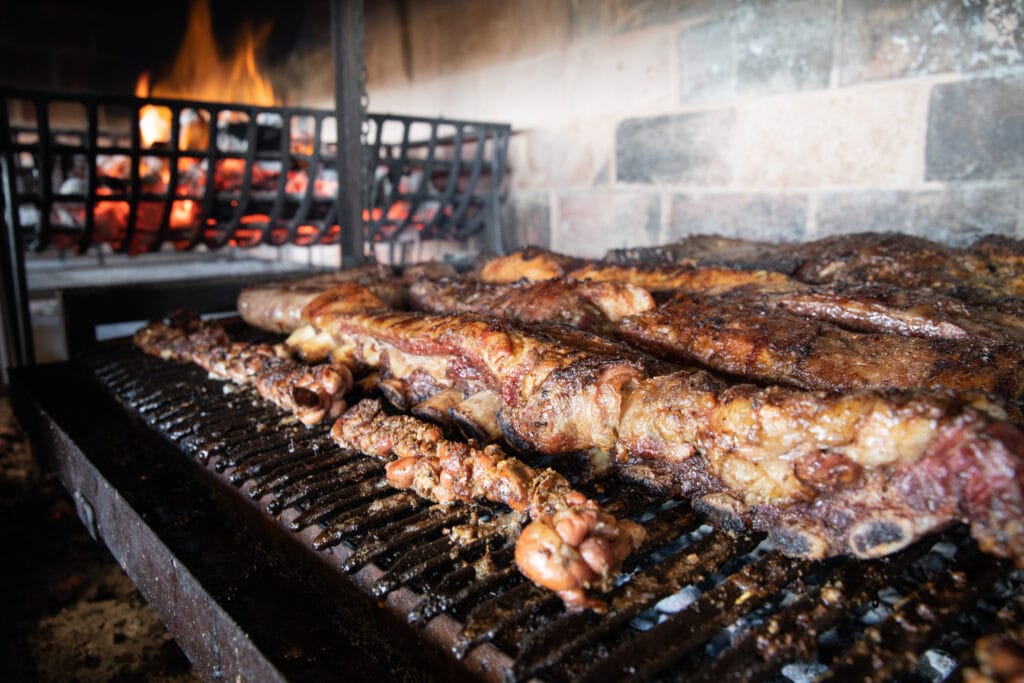I have always found the chapter after the New Year to be exceptionally long and drawn out. The festivities are well and truly over, and everyone is trying their best to be healthy and boringly well-behaved. The prospect of heading abroad to warmer climes seems far more appealing. It would be hard to think of the Rio Grande in January as warm, but at least Buenos Aires would be. Besides, when one travels as far south as the Rio Grande it is hardly to catch a few rays. There are better places for that than this windy and often cold land of fire. I, like many others, travel halfway around the world to the bottom of Patagonia to give myself, and others, a chance to land the fish of a lifetime. A sea trout of a lifetime.
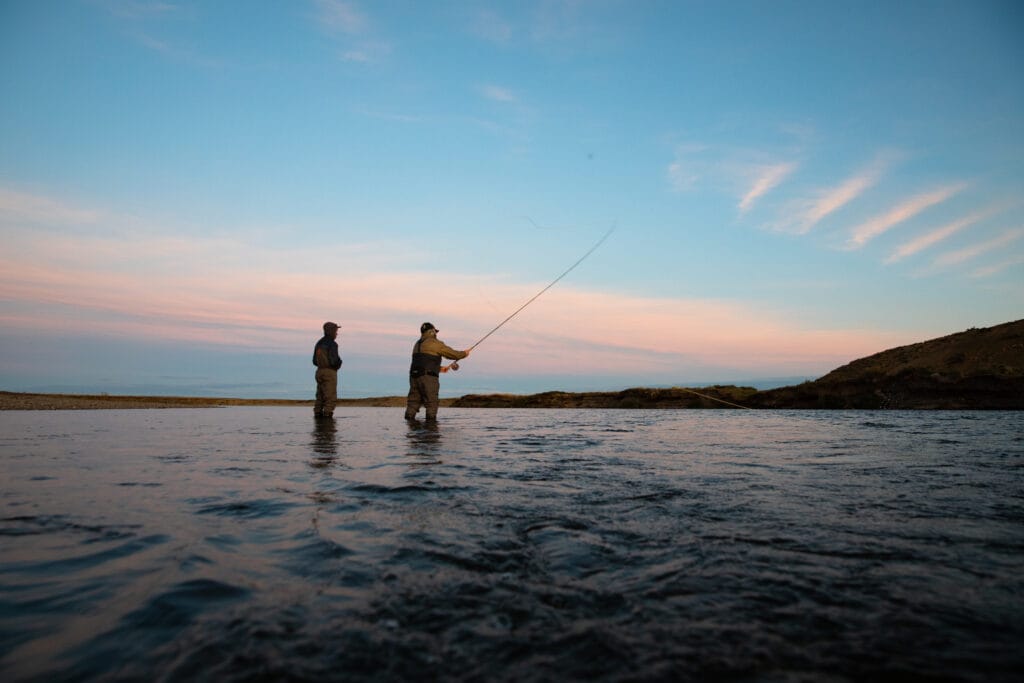
It was a pleasure to return to the Rio Grande with a group of rods who, other than one, had never seen this great river before. It is always exciting to show anyone the river for the first time. The excitement comes with a small pinch of nerves as you hope they see and experience the river in the same light you do. Having spoken with Peter, Manu, John and Chris many times before flying, I was sure they would.
In Buenos Aires, I met the others who, despite a long journey from the UK, were looking relatively fresh and were eager to head out for a protein-heavy lunch. In Argentina, it is a shame not to if you are that way inclined. Over beers and steak, we chewed the fat, got to know each other and spoke of the week ahead. I have always enjoyed the contrast between the hustle and buzz of Buenos Aires and the wilder and more raw landscape further south. They are two different worlds, which is not surprising given that a three-hour flight separates them. That evening we would leave on an annoyingly late flight for Rio Grande. We arrived early in the morning of the following day. A few hours of sleep in the Grande Hotel on the other side helped us to recharge a little before heading to Estancia Maria Behety at lunchtime. Thankfully we knew that when we arrived, there was little to do than prep kit and unwind, eat good food and down a glass of Malbec or two.
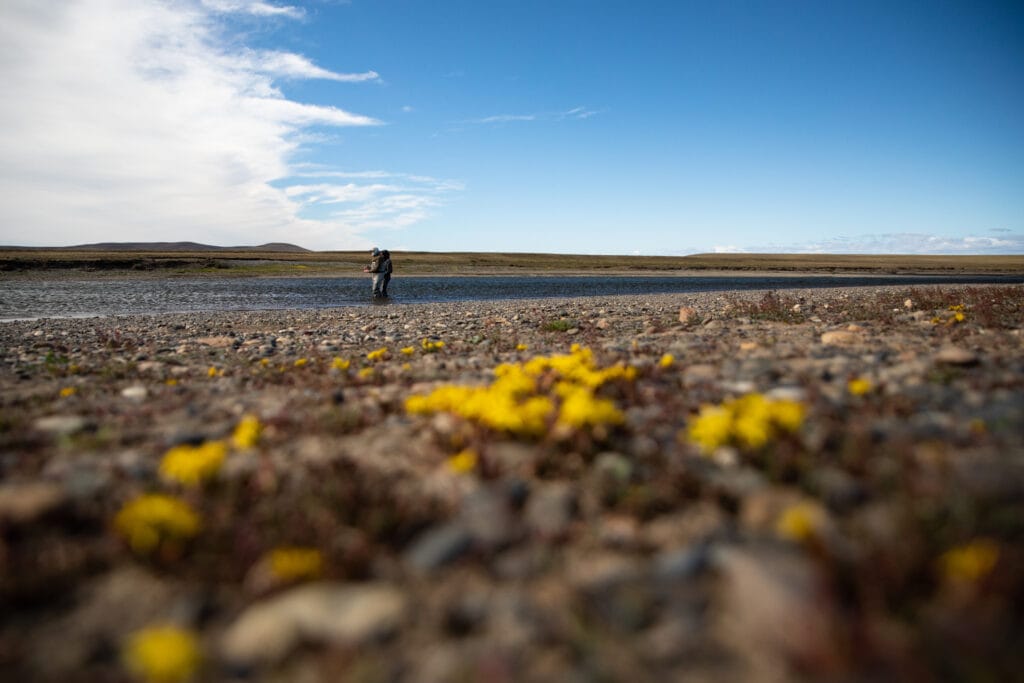
Last season I visited Estancia Maria Behety for the first time. I had not been to the Rio Grande since guiding at Kau Tapen on the other side of the river some years ago. Returning was already like seeing an old friend. The lodge was as warm and comfortable as ever, and the unchanged guide team and lodge staff were waiting, open-armed and ready to greet us in the main hall. I have said it before, but the lodge has found the balance between comfort and character as well as any I have seen. It is not surprising that so many rods return each season.
On the first morning, we woke to gentle wind and bright sunny conditions, which most would consider the usual for this part of the world. I joined John and Manu for the morning session. Both had fished a lot for a mixture of species, primarily trout, with a bit of salt water in between. They had limited experience with two-handed sticks, so I thought that I might be able to help. Although their experience was limited, it was clear that they could transfer their existing knowledge to Rio Grande style fishing quite quickly. The bright conditions meant the fish were less active than we had hoped. In truth, I was not too worried as we knew this first session would always be an icebreaker and a warm-up of the shoulders. Despite connecting with only one fish for the session, John was happy. I watched him figure-of-eight a small sunray when the line was ripped from his fingers before he could react. For John, a true angler, this and the sight of a twenty-pounder roll was enough for the first session.
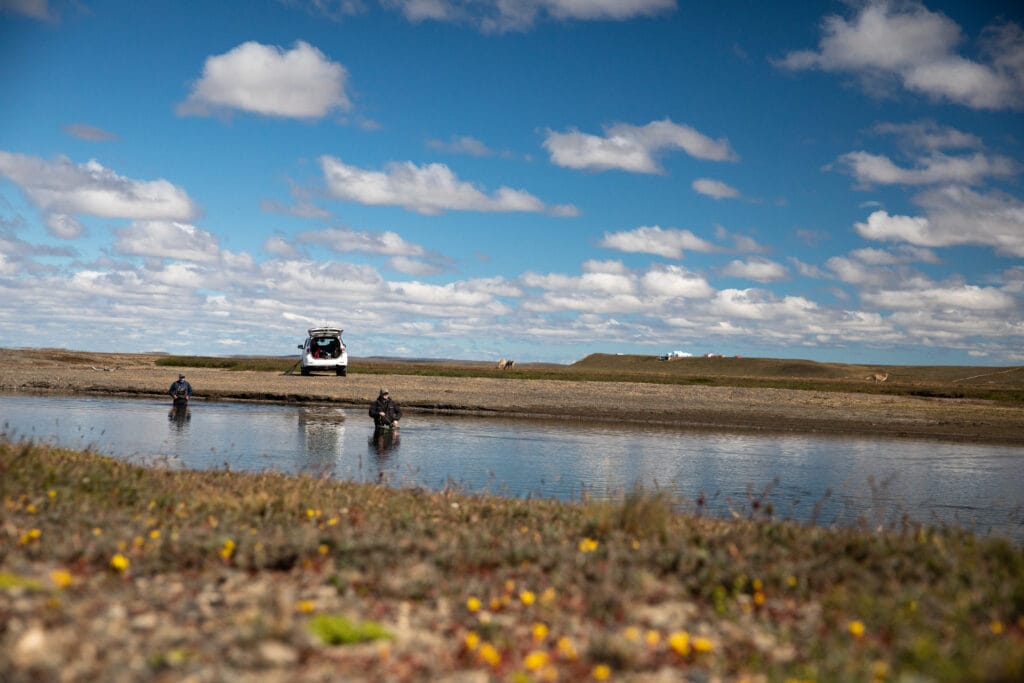
That evening I joined Genaro, the head guide and had a few casts myself. With bright shining down the river and in the fish’s faces, I knew we would be waiting until dark for the fish to become more active. I had only met Genaro briefly the year before, so now was an excellent opportunity to pick the brains of a guide who has spent almost 20 seasons on the river. It was interesting to see Genaro’s approach to the pools and his way of fishing them. Due to the low water, a stealthy approach was critical. This meant scandi lines, light tips and long leaders. Start at the top; if nothing happens, fish through the depths with heavier tips. Genaro was quick to show us the best-taking spots where we needed to focus our time. The Rio Grande is rarely a river that rewards those who blindly chuck and chance. Playing with casting angles, the speed of the retrieve and flies in the hot spots can be the difference between a great or an okay session when the fishing is more challenging.
When you are on the other side of the world enjoying the delights of a British winter, the evening sessions on the Rio Grande seem like a distant and faded memory. A camera in the hands of a talented photographer does little to truly capture the shades of red, orange and amber burnt across the vast Tierra Del Fuego sky. The wind had died, and I was by myself, wrapped in the quietness of the evening. A younger me would have focused on the fishing only, but instead, I stopped and turned to look at the sky. Just for a moment, long enough to capture an image better than any camera. I went back to casting and stripping my sunray slowly. Like John in the morning, the line was ripped from my hands by a savage take. Another one that didn’t stick. Five minutes later, it did. Soon after, a coin silver fish of four pounds was dancing in the net. One more, a little larger, was my fill for the evening’s work.
At the lodge, I caught up with the others and heard how they had faired. Everyone had seen fish, and some had caught. Nothing significant banked, but everyone had seen the kind of fish we had come for, and that makes the legs go a wee bit wobbly. John hooked and then lost a good fish on beat 15, so he was inching closer to catching something memorable.

I joined Peter and Chris the following morning to enjoy their company, see how they were getting on, and take a few photos. They have known each other for decades and have fished many places together, especially Los Roques. They were not shy of reminiscing about their trips and recounting memories of stumbling home after drinking one too many rather moreish mojitos made with Los Roques homebrew. Peter had fished at EMB a few years earlier at the same time of the season, so he had convinced Chris to join him for this trip. I heard it took little convincing, and it was great to see Chris fully appreciate the whole experience besides the fishing. It always takes a little time to get to grips with how to use the wind on the Rio Grande, as it is unlike salmon fishing back home. Peter and Chris soon got accustomed to casting with a strong wind on their back, and it was not too long before their flies were tickling the high bank of Seagull Island, one of many great pools in EMB’s extensive repertoire.
Very bright conditions had made the fishing tough for the first few days of the week, especially early in the afternoon when the sun was shining down the river. But as is always the case with Rio Grande stick with it, and the river will reward persistence. At some point in the week, everyone hits a golden patch which proved to be the case after a couple of challenging days. Fishing with Miguel, Chris was the first to land something memorable with a stunning hen fish in the high teens caught from Leandro’s at dusk. As is generally the case at this time of the season, the fish was a solid bar of silver with not a bit of flab, all broad-backed muscle and shoulders. That evening we downed local beer and Malbec to raise a glass in salute.
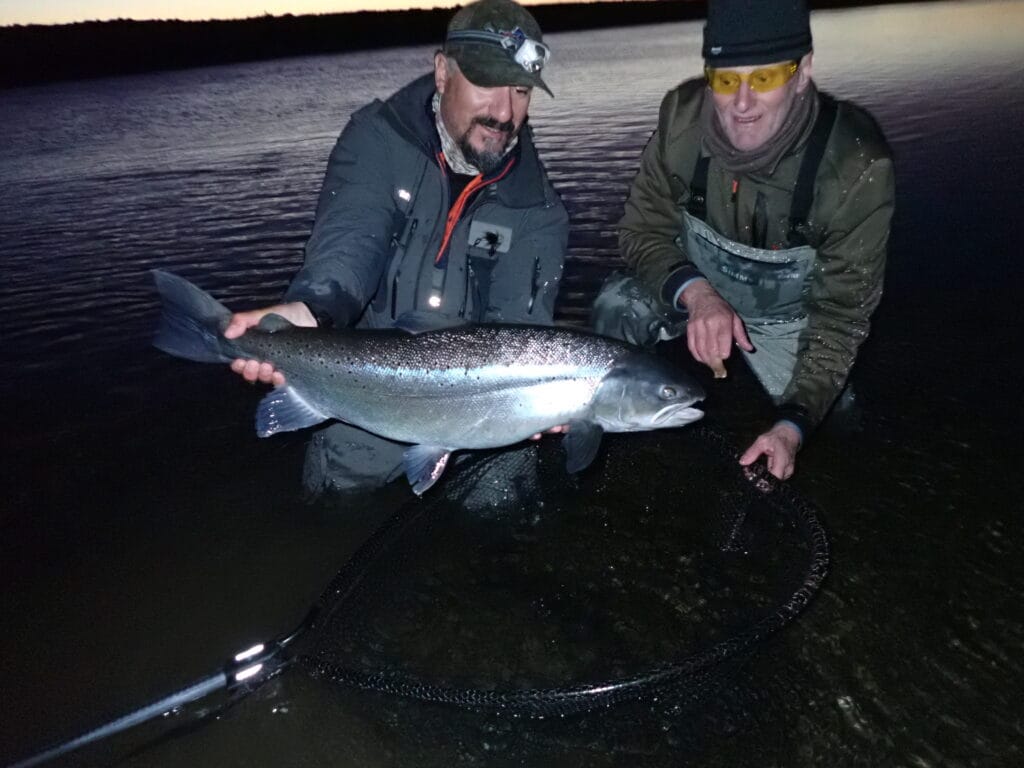
For the next few days, the conditions improved enough for the fishing to become more consistent. It was still brighter than you would wish for, but the wind remained steady and blew down the valley at a decent rate of knots. Bright sunny conditions with no wind can put the fish down when the water is low, so a rippled surface does help to cover the angler’s tracks. The evening sessions continued to provide the best fruits of the day. It always amazes me how you can fish a pool earlier in the afternoon, and it could be as quiet as the grave. Return at dusk once the light has dropped and the pool becomes alive with fish breaking surface and porpoising. You could swear it’s a different place or even river.
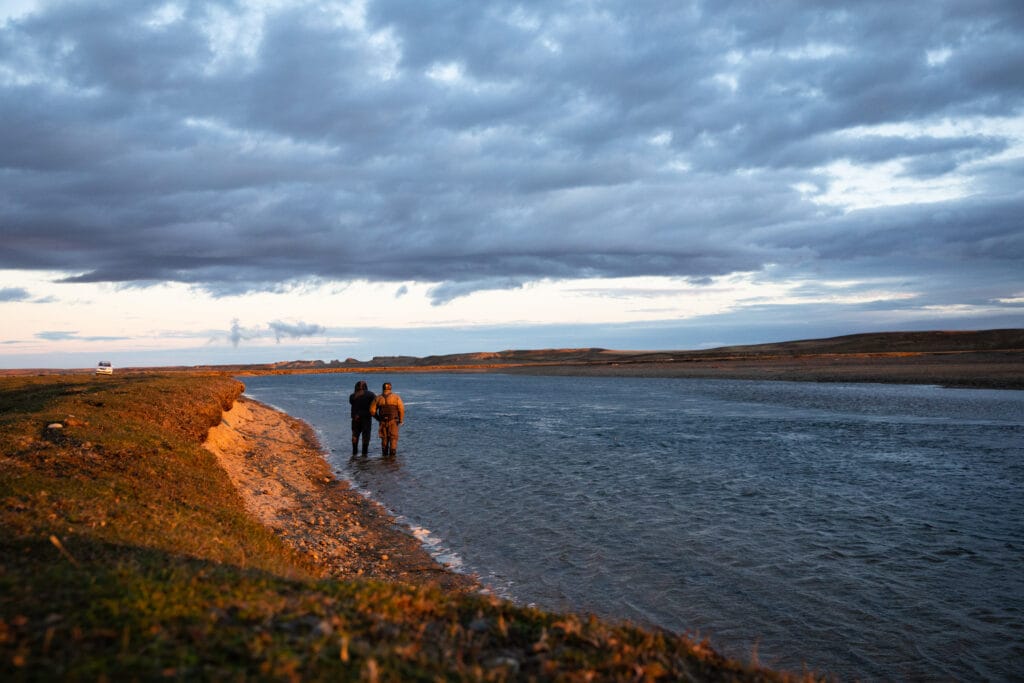
Such was the case when we fished Pedrero’s with Miguel. Because of the clear skies, the light had taken a long time to drop. It was 10.30 pm before fish started showing, but when they did, it was clear that the pool was stuffed. Hardly a second passed without another ten-plus pound fish rolling in front of me. The helpful wind from a few hours earlier was now blowing directly in our faces, not too strong but strong enough to convince me to switch to an overhead cast rather than the usual.
Despite endless fish showing, they did not take easily. After 20 minutes of trying, I was rewarded with a small shiny chap. I kept plugging away in the hope of something larger, changing the retrieve of my leech every so often. After another ten minutes, the line tightened with a solid stop, not aggressive, just solid. Solid and weighty. I lifted into the fish and knew that this was not another good fish but something a little more. The first run took me close to the backing. Like the take, the run was not aggressive but powerful and purposeful. A further 20 minutes and several runs later, the fish still wasn’t easing, but I had the shooting head through the tip of the rod. It was like having a stubborn dog on the lead that was hugging the floor and refusing to budge. I kept the pressure, bending the rod to the cork without trying to pull too hard. This game of catch and mouse continued for a few more minutes. It pulled and took a little line. I pulled back and retrieved a little. The fish pulled again but this time, the line went slack. I am generally not one for loud vocals when losing fish, but this time was an exception. I wouldn’t want to tag a number to the size of the fish, but I have never hooked a sea trout that has felt anywhere as large. Much of the pain of losing a fish like this is not knowing. We have all been there. The one that got away cannot be forgotten and is a memory that remains branded to you forever.

At the lodge, the rest of the team had good fishing, and Manu and John came into their own with some cracking fish. John with a stunning 16lb fish. Like Chris’s, an excellent hen fish. Not a scale out of place and as silver as you could hope for. Fishing in the first half of January is about something other than catching the most fish of the season. It is about allowing yourself to catch some of the season’s hardest-fighting and brightest fish. John was delighted with his fish but told me that although the fish was strong, the fight from a smaller fish earlier in the evening was equally as impressive.
That evening Manu needed no encouragement to be the head honcho of the bar and began prepping some rather punchy Martinis for the team. He was particular about the ins and outs of producing this potent little mix in a way that only the best Italians are. We sipped, we drank, and we dissected the day’s events.
It was a pleasure to fish with Genaro for the second time in the week and to be heading downriver to beat 32. While fish were spread throughout the lower and middle parts of the river, it is undoubtedly true that the lower beats tend to fare best at this time of the season. What followed that morning was one of the most enjoyable experiences I have had on the Rio Grande. It was by no means an easy morning, but it was rewarding. Fish showed from our arrival until we left. They didn’t take freely, but they did take. Every fish caught came from carefully considered casts and fly changes. The challenge was remembering what you did to get the fish to take. Every fish was fresh from the morning’s high tide and hard fighting. Not a scale was out of place with any.
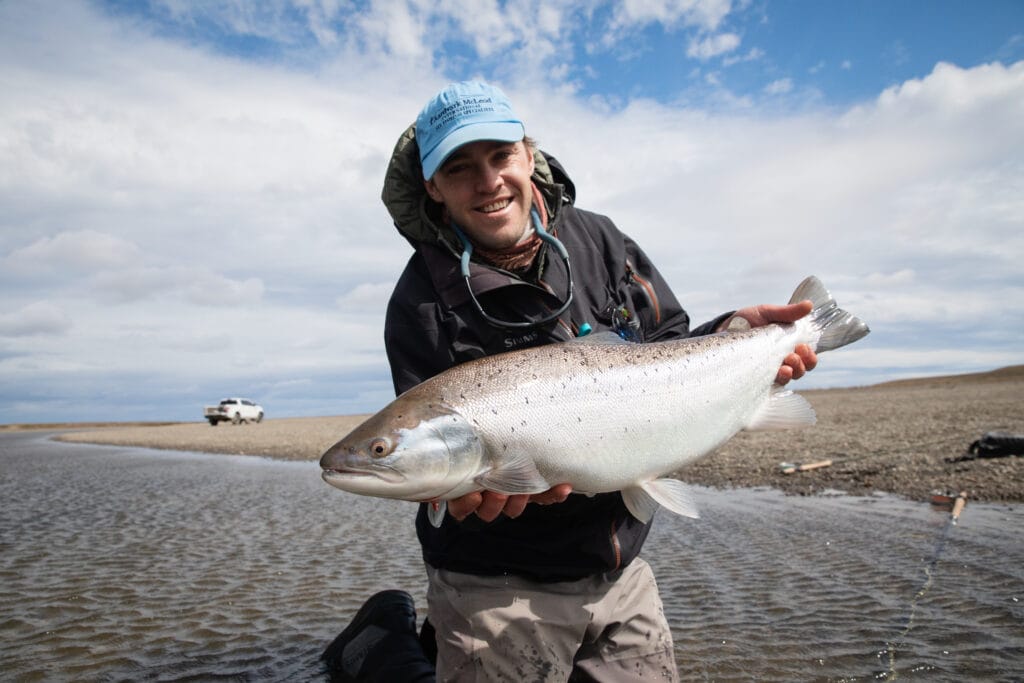
Lunch was at the asado hut rather than the lodge, which was built a few years ago and was designed by Ropo’s daughter. It sits below the main lodge and is easy to miss if you didn’t know it was there as it sits into the side of the hill. The glass front allows for unhindered panoramic views of the landscape below. I can think of very few places anywhere in the world that are better to enjoy the best Argentine food, wine and hospitality. Seeing the rest of the group gel together with so little effort was excellent. The guides sat with us while we ate at the asado hut, adding a little extra to what seemed the perfect lunch. The guide team at EMB is one of the strongest on the river, and you would need help finding a more experienced and easy-going lot at any lodge anywhere in the world. Made docile by overeating local lamb, we all made the most of the opportunity to have a small siesta before the evening session. When the days are longer at this time of the season, one day is really two, and a few hours kip works wonders to help give enough juice for the evening session.
A nippy wind at the end of the evening session put the fish down a touch, as is often the way when there is a dramatic temperature change. Fortunately, before this happened, conditions were good enough for everyone to have good fishing. Peter banked a few, and Chris landed another fine fish but had stories of the one that got away.
The following evening sessions continued in a similar vein, with a bitterly cold wind once the light dropped. Once active and full of life, a pool soon died once the chill wind rippled the water’s surface. Sea trout are funny creatures that seem more susceptible to changing conditions than many species.
Although he had been catching fish, Manu had to wait a little longer than some to come into his own. On the penultimate afternoon session, John hooked but struggled to get anything of note to stick. It wasn’t the case for Manu, his partner, who landed a handful of good fish and one in the mid-teens. Caught in Leandro’s against a backdrop of scarlet and amber, it would be hard to imagine a scene more fitting of Tierra del Fuego than this.
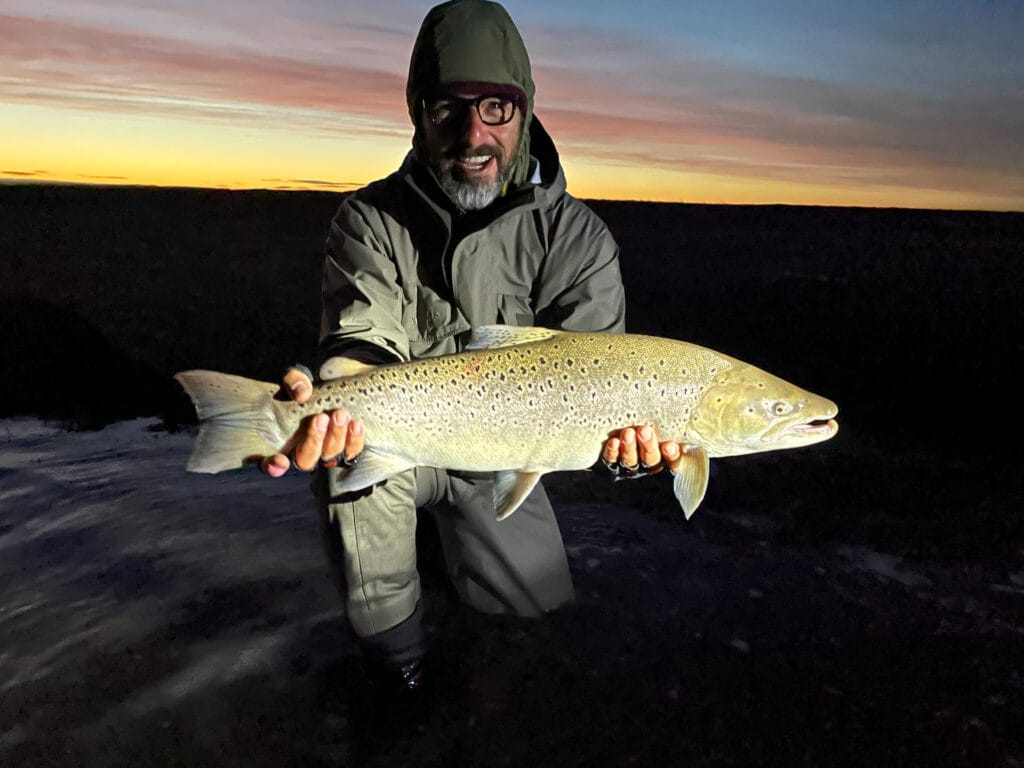
Not that it needed reconfirming, but this week clarified just how unique the Rio Grande and Estancia Maria Behety are. Due to the challenging conditions, the fishing had undoubtedly been challenging, but Peter, Chris, John, and Manu all caught some great fish. As is always the way with the Rio Grande, persistence and consistency pay dividends. Fishing earlier in the season is about something other than catching the most fish. It is about catching the best fish. It is about knowing that the next high spring tide will bring in some of the best-conditioned and hardest-fighting sea trout you are ever likely to catch. There are numerous beautiful lodges on the river, but this week cemented why Estancia Maria Behety is one of the best. Returning to the lodge is different from staying in some flash hotel. It is like returning home. While it could not be more relaxed, everything runs like a Swiss watch. When you return, Mariana and the girls will welcome you with beaming smiles and a glass of your favourite tipple. Ropo will be ready to chat about fishing. The fire will be roaring, and the food will be memorable. Whether the fishing is excellent, good or a little trickier, all the guides will be on point, work hard, think hard and constantly tinker with tactics until they have found the right one.
The final evening was spent with the guides and more delicious finger food than you could wish for before returning to a freshly made bed for the last time. We flew to Buenos Aires together. Manu and John had their international flights that day, while I stayed one extra night in Buenos Aires with Peter and Chris. Keen to have a lighter supper, we ate at a fabulous Italian around the corner from the Casasur Bellini, where we were staying. Spending another relaxed evening with Chris and John confirmed how easy-going and fun the group had been. It was lovely to see them fully immerse themselves in the Argentine experience because, ultimately, travelling to Argentina is about the whole trip, not purely fishing.
For more information on fishing in Argentina or if you would like to join Olly next January, EMAIL US or phone (+44) 01980 847 389.
